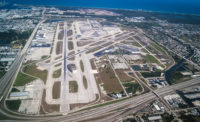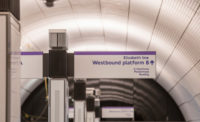 |
| Anthony Bartolomeo |
I have not-so-groundbreaking news to share: America’s infrastructure is underfunded. Very few within the civil engineering profession would consider the deteriorating condition of our nation’s infrastructure a revelation—it was demonstrated by the D+ grade point average reported in ASCE’s 2013 Report Card for America’s Infrastructure. Beyond the fact that we received a nearly failing grade, a lack of appropriate infrastructure investment directly impacts America’s productivity, quality of life, future growth and prosperity.
Against this backdrop, the civil engineering profession has a clear responsibility and opportunity. We can transform the current landscape and again live in a reality in which infrastructure is the foundation of a thriving society. This is the mission of the American Society of Civil Engineers’ Grand Challenge, an intentionally bold directive that provides us with the chance to broaden our understanding of our role as civil engineers.
What is the ASCE’s Grand Challenge? Imagine you had to reduce life-cycle infrastructure costs by 50% in less than a decade (by 2025) while fostering the optimization of infrastructure for society. What ideas, business models and methods can we bring to the table? To inspire transformational success, this challenge was created to match the ambitious goals that have historically led to significant advancement in infrastructure, science and sustainability.
One of them, the building of the Interstate Highway System in the 1950s, is considered one of the greatest public-works projects in history and is one example of a visionary, forward-thinking goal. It would be hard to imagine our country without this transformational project that allowed unparalleled freedom of movement. Another visionary goal was set in 1960, when President John F. Kennedy announced the ambitious goal of sending an American to the moon before the end of the decade. This technological feat inspired Americans to think big.
As a more recent example of a transformational undertaking, Jason McLennan spearheaded the Living Building Challenge, the most progressive and stringent green-building guidance system in the world. Turning the idea for Living Building into a reality, McLennan has geared this new program to help the industry exceed the goals advocated by LEED and other rating systems.
Infrastructure’s Future
We now have an opportunity to apply bold thinking to shape the future of our country’s infrastructure. ASCE has been a leader in bringing infrastructure issues and solutions to the forefront through initiatives such as the Failure To Act Economic Studies, the ASCE Innovation Contest, #GameChangers and more. The next inspirational goal for all civil engineers, the ASCE Grand Challenge, is meant to drive new ideas in our work.
The Grand Challenge’s ideas first began to develop at the ASCE’s inaugural Innovation Contest, which asked for ways to use technology from other industries. The winning submission, from HDR’s Jason Magalen, investigated ways to use small unmanned aerial vehicles to collect data about coastlines. Another winning submission, by college student Morgan DiCarlo, highlighted ways in which collecting and sharing information can affect the psychology behind daily water use. These ideas reflect the profession’s movement toward innovation. The second Innovation Contest is now taking submissions, seeking ideas to transform civil engineering.
ASCE also has launched a Grand Challenge website where you can submit stories about how to make progress. There are other ways to participate, as well, such as asking the right questions at the beginning of projects, including resilience strategies in a request for proposals, or discussing your Grand Challenge ideas with colleagues. A key part of the challenge’s success will be realized when you share your commitment with peers.
As past chairman of ASCE’s Industry Leaders Council, I appreciate civil engineers’ enthusiasm about this type of challenge. By 2025, you could be able to say you’ve been a part of the solution and a turning point in infrastructure development. With your commitment, we’ll be on our way to transforming the way we plan, deliver, operate and maintain our nation’s infrastructure. You will help us meet the real challenges of tomorrow.
If you have an idea for a column, please contact Viewpoint Editor Richard Korman at richard.korman@construction.com.






